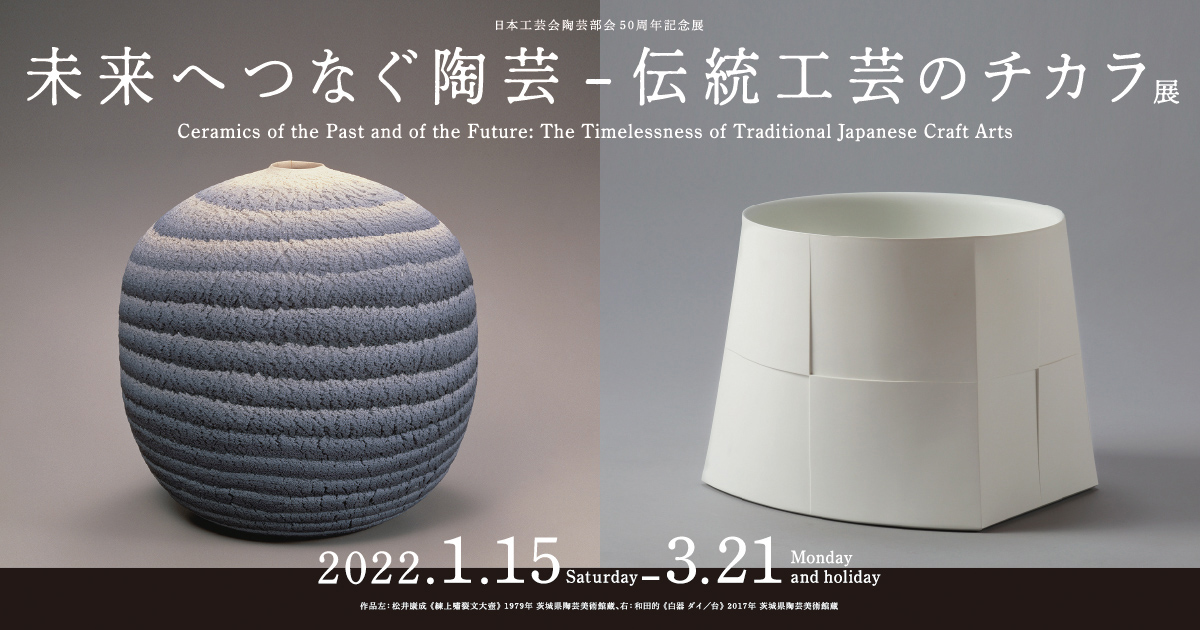Ceramics of the Past and the Future: The Timelessness of Traditional Japanese Craft Arts

To those who wish to visit the "Ceramics Ceramics of the Past and the Future: The Timelessness of Traditional Japanese Craft Arts″ exhibition
To prevent the spread of COVID-19, we would like to request that you reserve the date and time of your visit in advance from our reservation website.
All advance reservations are no longer accepted.
- The admission fee is to be paid upon your visit.
- We are not accepting reservations by phone or at the museum reception.
General Information
- Dates
- January 15 - March 21, 2022
- Hours
- 10 a.m. – 6 p.m. (Admittance until 5:30 p.m.)
* Open until 8 p.m. (Admittance until 7:30 p.m.) on February 4 and March 4.
To prevent the spread of COVID-19 infection, the nighttime opening planned will be cancelled.
- Closed
- Wednesdays (Except for February 23)
- Admission
- Adults: ¥1,000
Visitors aged 65 or over carrying proof of age: ¥900
Students (College): ¥700
Students (High / Middle school): ¥500
Admission is free for children in primary school and younger.
Admission is free for disability passbook holders and up to one accompanying adult.
- Organizers
- Panasonic Shiodome Museum of Art, Japan Kōgei Association, NHK PROMOTIONS INC.
- Producer
- NHK ENTERPRISES, INC. Nagoya Branch Office
- Supporter
- Minato City Board of Education
Exhibition overview
Japan’s proud tradition of ceramic art has diversified in technique and artistic style over the centuries and continues to evolve in remarkable ways today. Ceramicists have become more prolific since the postwar era, producing ambitious works one after another.
In 1950, the Japanese government enacted the Law for the Protection of Cultural Properties to preserve and promote artisan crafts known as kōgei, which are artisan crafts associated with specific regions and craft traditions within Japan and encompass a variety of disciplines including ceramics. Following an amendment to the law in 1954 that allowed for individual craft artists to be designated as Preservers of Important Intangible Cultural Properties (or Living National Treasures), a group of such artists founded the Japan Kōgei Association in 1955. The association was cofounded with other artisans and craftspeople working in the various fields of traditional kōgei. Members of the association display their art at the Japan Traditional Kōgei Exhibition. In addition, every year since 1973, the Ceramics Division of the association has hosted an Exhibition of New Ceramic Works, an opportunity for member artists to showcase their latest works.
In commemoration of the 50th anniversary of the Japan Kōgei Association’s Ceramics Division, this exhibition offers a retrospective view on the organization’s history and a selection of masterpieces by its artists. The artistry and beauty of ceramic art are demonstrated in a selection of tea bowls and other works by artists who have mastered the unique materials and traditions of kōgei ceramic styles, including current and former Living National Treasures. A selection of works by up-and-coming artists is another highlight of the exhibition.
The Shiodome Museum of Art has held many exhibitions celebrating kōgei and design. This exhibition will feature about 140 works, with a focus on contemporary ceramics; most of the artists are members of the Japan Kōgei Association’s Ceramics Division.





